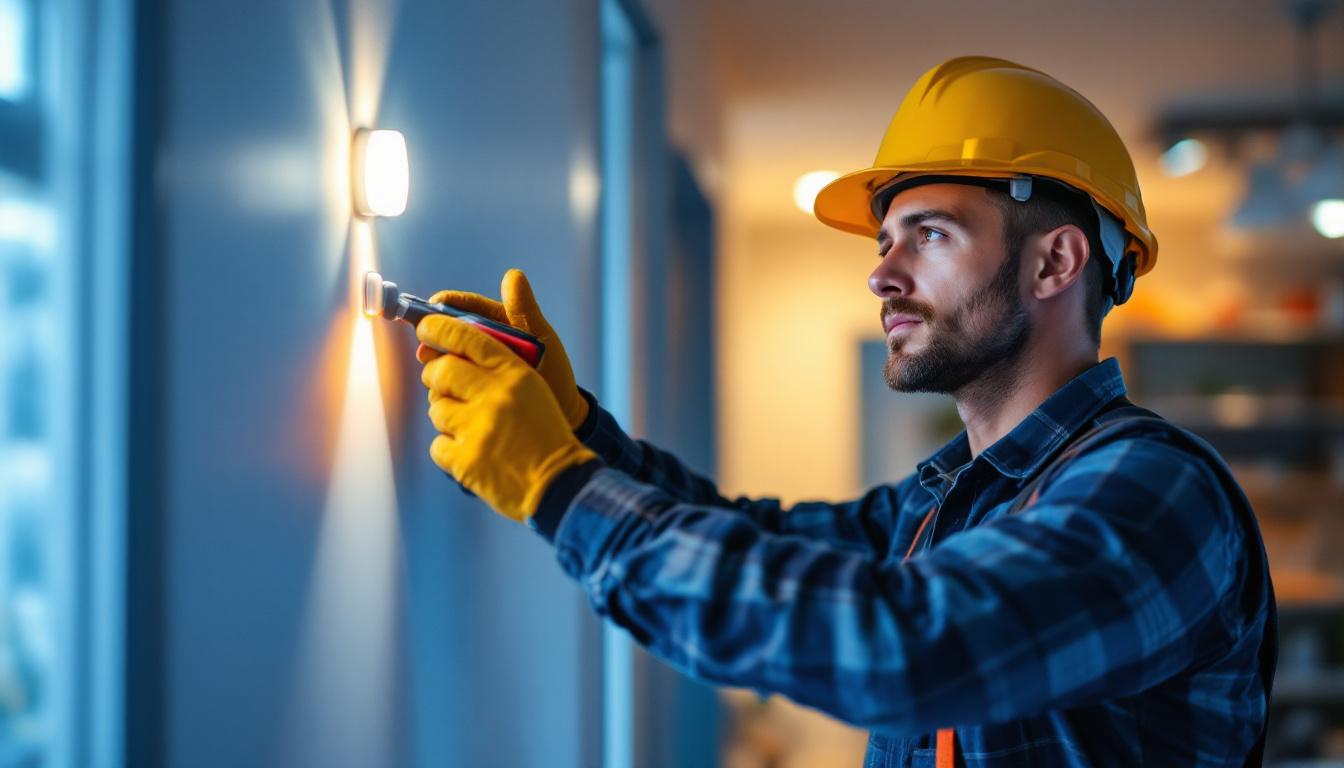
In the ever-evolving world of lighting design and installation, understanding the nuances of various lighting systems is crucial for lighting contractors. Keystone lights, a popular choice in both commercial and residential settings, offer unique benefits that can enhance any project. This article delves into the essential aspects of keystone lights that every lighting contractor should be familiar with, from their functionality to installation techniques and maintenance considerations.
Keystone lights, often referred to as keystone fixtures, are a type of lighting solution that utilizes a specific design to maximize efficiency and aesthetic appeal. These lights are typically used in settings where high-quality illumination is required, such as offices, retail spaces, and even outdoor environments.
Keystone lights are characterized by their unique shape and design, which often includes a rectangular or square housing that allows for optimal light distribution. They are available in various types, including LED, fluorescent, and incandescent options, making them versatile for different applications. The term “keystone” is derived from the architectural element that provides structural integrity, symbolizing the strength and reliability of these lighting fixtures.
One of the standout features of keystone lights is their ability to produce a high lumen output while consuming minimal energy. This efficiency not only reduces electricity costs but also contributes to a lower carbon footprint, making them an environmentally friendly choice. Additionally, many keystone lights come equipped with advanced features such as dimming capabilities and smart technology integration, allowing users to customize their lighting experience according to their specific needs and preferences.
These lights are particularly favored in commercial applications due to their energy efficiency and long lifespan. They are commonly installed in offices, warehouses, and retail environments, where consistent and bright lighting is essential. Additionally, keystone lights can be used in residential settings, such as garages and basements, where functional lighting is needed.
Moreover, their design allows for easy integration into existing lighting systems, making them a popular choice for retrofitting projects. This adaptability can significantly enhance the overall lighting quality in any space, providing a seamless transition from older, less efficient fixtures. In educational institutions, keystone lights are increasingly being adopted in classrooms and hallways, where bright and evenly distributed light can improve visibility and create a conducive learning environment. Furthermore, outdoor applications, such as parking lots and pathways, benefit from the durability and weather resistance of keystone lights, ensuring safety and security during nighttime hours.
The advantages of using keystone lights extend beyond their aesthetic appeal. They offer numerous benefits that can improve both the functionality and efficiency of lighting systems.
One of the most significant benefits of keystone lights, particularly LED options, is their energy efficiency. These fixtures consume less electricity compared to traditional lighting solutions, resulting in lower energy bills and a reduced carbon footprint. This aspect is increasingly important as businesses and homeowners alike seek to minimize their environmental impact.
Furthermore, many keystone lights are designed to last longer than traditional bulbs, which means fewer replacements and less waste. This longevity not only saves money but also contributes to a more sustainable approach to lighting. The reduced need for frequent bulb changes also means less disruption in both residential and commercial spaces, allowing for a more seamless experience in daily operations.
Keystone lights are engineered to provide high-quality illumination that enhances visibility and reduces shadows. This is particularly important in commercial settings where poor lighting can affect productivity and safety. The even distribution of light minimizes glare and creates a more pleasant environment for employees and customers alike.
Additionally, the ability to choose different color temperatures allows contractors to tailor the lighting to specific needs, whether it’s a warm ambiance for a retail space or bright, cool lighting for an office environment. This customization can significantly influence mood and behavior; for instance, warmer tones can create a cozy atmosphere that encourages relaxation, while cooler tones can enhance alertness and focus. Moreover, the adaptability of keystone lights makes them suitable for a variety of applications, from illuminating warehouses to accentuating artwork in galleries, showcasing their versatility in meeting diverse lighting requirements.
Proper installation is crucial for maximizing the performance of keystone lights. Understanding the best practices can ensure that these fixtures operate efficiently and effectively.
Before installation, it is essential to conduct a thorough assessment of the space. This includes measuring the area, determining the appropriate number of fixtures needed, and identifying the best locations for installation. Proper planning can help avoid common pitfalls and ensure optimal light coverage.
Additionally, reviewing local building codes and regulations is vital to ensure compliance. This can prevent potential issues down the line and ensure a smooth installation process.
The installation process for keystone lights typically involves several key steps. First, ensure that the power supply is turned off to avoid any electrical hazards. Next, mount the fixtures according to the manufacturer’s instructions, ensuring they are securely fastened and positioned correctly for optimal light distribution.
Wiring is another critical aspect of the installation process. Properly connecting the electrical components is essential for the functionality of the lights. It is advisable to use high-quality wiring materials and follow safety protocols to prevent any electrical issues.
Once installed, regular maintenance is necessary to ensure the longevity and efficiency of keystone lights. Understanding how to troubleshoot common issues can also save time and resources.
Regular cleaning of the fixtures is essential to maintain optimal light output. Dust and debris can accumulate on the surface, reducing the effectiveness of the lights. Using a soft cloth and mild cleaning solution can help keep the fixtures in good condition.
Additionally, periodic inspections of the electrical connections and wiring are important. This can help identify any potential issues before they become significant problems, ensuring that the lights continue to operate efficiently.
Despite proper installation and maintenance, issues may still arise with keystone lights. Common problems include flickering, dimming, or complete failure of the fixtures. In many cases, these issues can be traced back to faulty wiring or loose connections.
If flickering occurs, it may be necessary to check the compatibility of the dimmer switch with the type of keystone light installed. In cases of complete failure, inspecting the power supply and ensuring that the circuit is functioning properly can often resolve the issue.
With a variety of keystone lights available on the market, selecting the right fixtures for a specific project can be challenging. Understanding the key factors to consider can help contractors make informed decisions.
When choosing keystone lights, contractors should consider the type of lighting technology that best suits the application. LED options are increasingly popular due to their energy efficiency and longevity. Fluorescent lights may still be suitable for certain applications, while incandescent options can provide a warm ambiance in residential settings.
Additionally, the design and aesthetic of the fixtures should align with the overall style of the space. Choosing fixtures that complement the architecture and interior design can enhance the overall appeal of the environment.
Another critical factor is the brightness of the lights, measured in lumens. Different applications may require varying levels of brightness, so it is essential to assess the specific needs of the space. For instance, a retail environment may benefit from brighter lighting to highlight products, while a cozy restaurant may opt for softer illumination.
Color temperature is also an important consideration. Warmer tones (around 2700K-3000K) create a welcoming atmosphere, while cooler tones (4000K-5000K) are ideal for workspaces that require focus and concentration. Understanding the desired ambiance can guide the selection of the appropriate color temperature.
The lighting industry is continuously evolving, and staying informed about future trends can help contractors remain competitive. Keystone lights are no exception, with advancements in technology and design shaping their future.
One of the most significant trends in lighting is the integration of smart technology. Smart keystone lights can be controlled remotely, allowing users to adjust brightness, color temperature, and even set schedules. This level of control enhances convenience and can lead to further energy savings.
As more clients seek energy-efficient and technologically advanced solutions, incorporating smart lighting options into projects can set contractors apart in a competitive market.
With a growing emphasis on sustainability, the demand for eco-friendly lighting solutions is on the rise. Keystone lights that incorporate recyclable materials and energy-efficient technologies are becoming increasingly popular. Contractors who prioritize sustainable options not only meet client demands but also contribute to a greener future.
Keystone lights represent a versatile and efficient lighting solution that every lighting contractor should understand. From their unique design and benefits to installation techniques and maintenance considerations, being well-versed in keystone lights can enhance the quality of projects and client satisfaction.
As the lighting industry continues to evolve, staying informed about trends and advancements will ensure that contractors remain competitive and capable of meeting the diverse needs of their clients. By embracing the benefits of keystone lights and incorporating them into projects, contractors can deliver exceptional lighting solutions that stand the test of time.
Ready to elevate your lighting projects with the efficiency and versatility of keystone lights? Look no further than LumenWholesale, where we provide contractors with spec-grade lighting products at unbeatable wholesale prices. Our commitment to quality and affordability ensures that you have access to the best lighting solutions without the burden of inflated markups. With our extensive selection that meets the highest industry standards and the convenience of free shipping on bulk orders, you can trust that you’re getting premium lighting at the best value. Don’t compromise on quality or cost—visit Wholesale Lighting at the Best Value and experience the LumenWholesale difference for your next project.

Discover innovative strategies employed by smart lighting contractors using 12-volt movement sensors.

Discover the essential checklist for lighting contractors focusing on LED fridge lights.

Discover the crucial role of canister lights in modern lighting design.

Discover why staying updated on shop light fixtures is crucial for every lighting contractor.